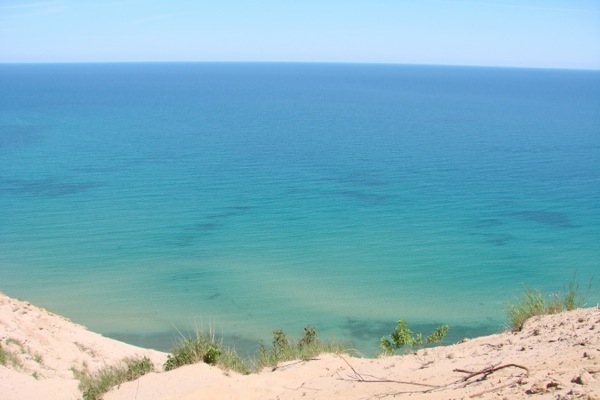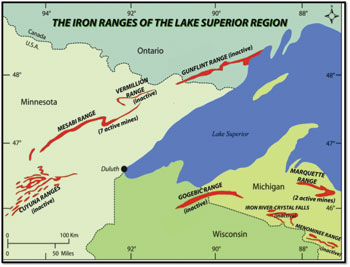US Midwest poised for a copper and iron ore mining rebirth

As usual, some have raised concerns about possible environmental damages, especially to the nearby lakes, such as Lake Superior (photo).
Mining for iron ore and copper in the US Upper Midwest is expected to stage a major comeback, as demand for both commodities locally and from foreign markets such as China continues to rise.
There are at least six mines proposed or already started in the area comprised by Michigan, Minnesota and Wisconsin. According to AP, there are also four new operations in Minnesota that are using advanced technology to extract iron ore from waste rock mined long ago.
Canadian Highland Copper Co. (TSX-V:HI) is one of the companies planning a new mine — the Keweenaw project—close to Lake Superior. The Michigan’s Upper Peninsula area, known as “copper country,” was an economic pillar for the US about a century ago. Over 11 billion pounds of native copper was produced between 1854 and 1976 in a district that is barely 160km long and less than 7km wide.
But the copper boom fell onto hard times as production shifted elsewhere and prices declined. By 1995 the last copper mine in Michigan’s Upper Peninsula had closed, leaving more than 1,000 people jobless.
Another project in the area is Lundin’s (TSX:LUN) Eagle Mine, a nickel and copper operation, previously owned by Rio Tinto (LON:RIO), which is scheduled to begin production this fall. According to the Lake Superior Community Partnership’s site, Eagle mine is expected to bring $4 billion into Marquette County over its eight-year lifespan, permanently employing 300 people and creating 1,200 indirect jobs.
As usual, some have raised concerns about possible environmental damages, especially to the nearby lakes.
Opponents claim there has never been a metallic sulfide mine that has not polluted water resources where water was present, and all the proposed mines are sulfide, says Stratus Consulting scientist Ann Maest, Ph.D., whose research found that 90% of the time “when you have a combination of sulfide mining and water resources there is a high likelihood you will have water quality problems.”
“These proposed mines would be among the largest in the US, and in some cases in the world. And they would be located in some of the country’s most treasured and unique freshwater ecosystems. The trouble is, sulfide mining and water just don’t mix,” writes Meleah Geertsma from the Natural Resources Defense Council.
Among the issues that concern locals, environmentalists and scientists, there is the question of whether the Michigan Department of Environmental Quality (MDEQ) properly assessed the potential for a mine collapse.
One of the ore bodies is located directly under the headwaters of the Salmon Trout River, says Geertsma, adding that a slump “would likely result in creation of acid mine drainage that would flow down the river and eventually to Lake Superior.”
But companies say they’ve learned from past mistakes and will leave a very small footprint this time around.
The Michigan Court of Appeals is currently hearing arguments in a case against the construction of Eagle mine, but has not made any decision yet.
*This article was originally featured with the image of a lake that was not Lake Superior.
More News
{{ commodity.name }}
{{ post.title }}
{{ post.date }}




3 Comments
geobob
While it’s true that metal sulfides + water = acid, but neither that fact nor examples of historic environmental degradation from mining are relevant to the proposed mines. The Eagle mine EIA (downloadable at http://eaglemine.com/ ) describes the baseline environmental data, maximum impacts from mining operations, mitigation of risks (backfilling of mined-out stopes, water treatment plant).
Neither the mining rate at Eagle (2,000 tons per day) nor the nature of the Keweenaw deposit of Highland Copper deposit mine) will qualify either as being “among the largest in the US… or world,” which is nonsense. Some larger Western US copper and coal mines move over half a million tons/day, so there’s no comparison.
frankinca
I agree, deception is the trademark of environmentalists who use selected words and suffixes to make a moot point. They are stone-agers, that should return to their old habitat. Every economic project that will provide jobs and an improved life circumstances is made to be a curse and the fish, lizards and insects rights are being taken, even if our constitution doesn’t specify that right. We need a Constitutional convention to iron out these rights and allow all species to have arms and protect their environs. Chase out those homo sapiens who are spoiling their environs. Send Columbus back to Spain, and start again. Or is it to late, and we should make the best of any opportunity to better the human condition!.
Mike Failla
Already the drumbeat of the luddites!